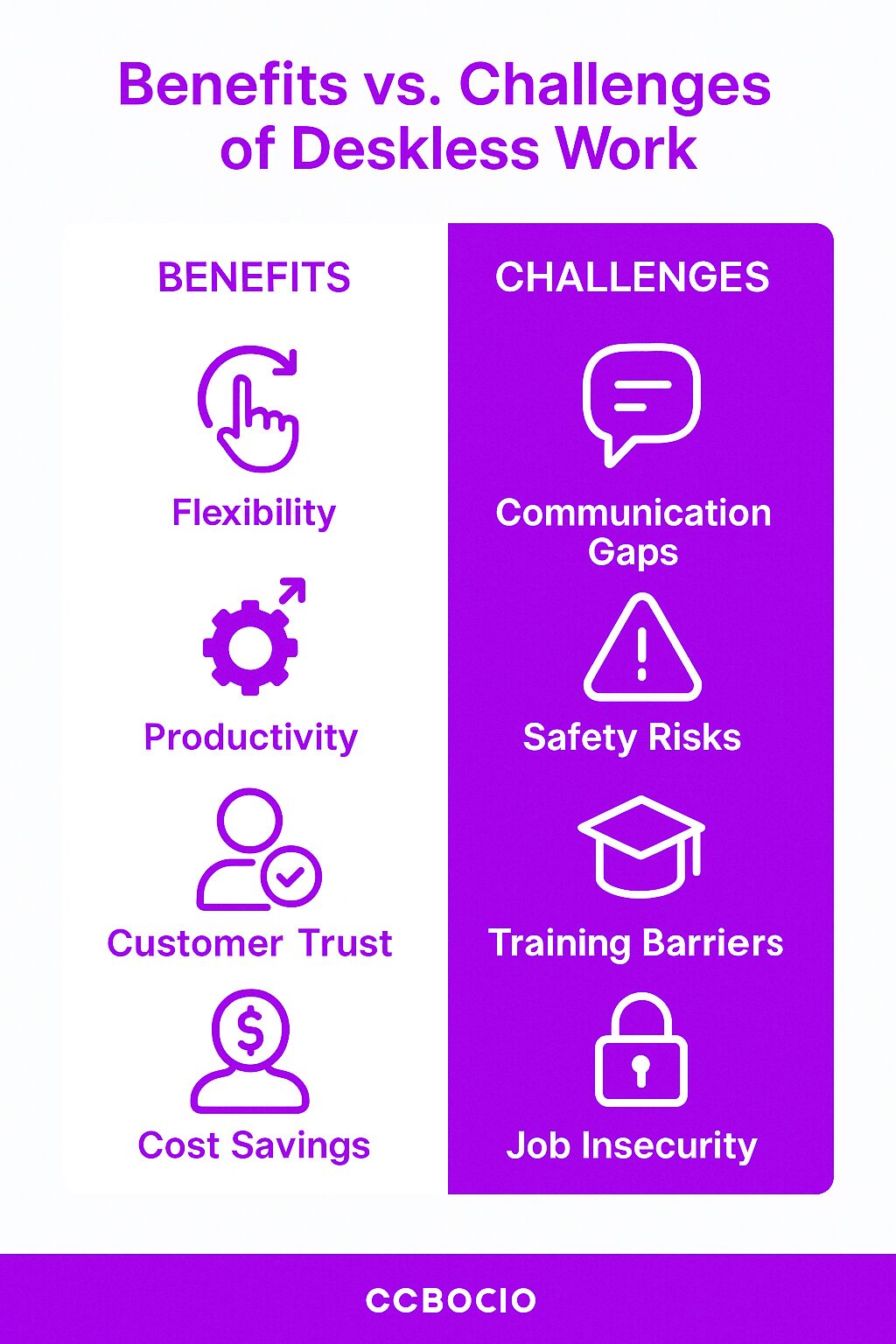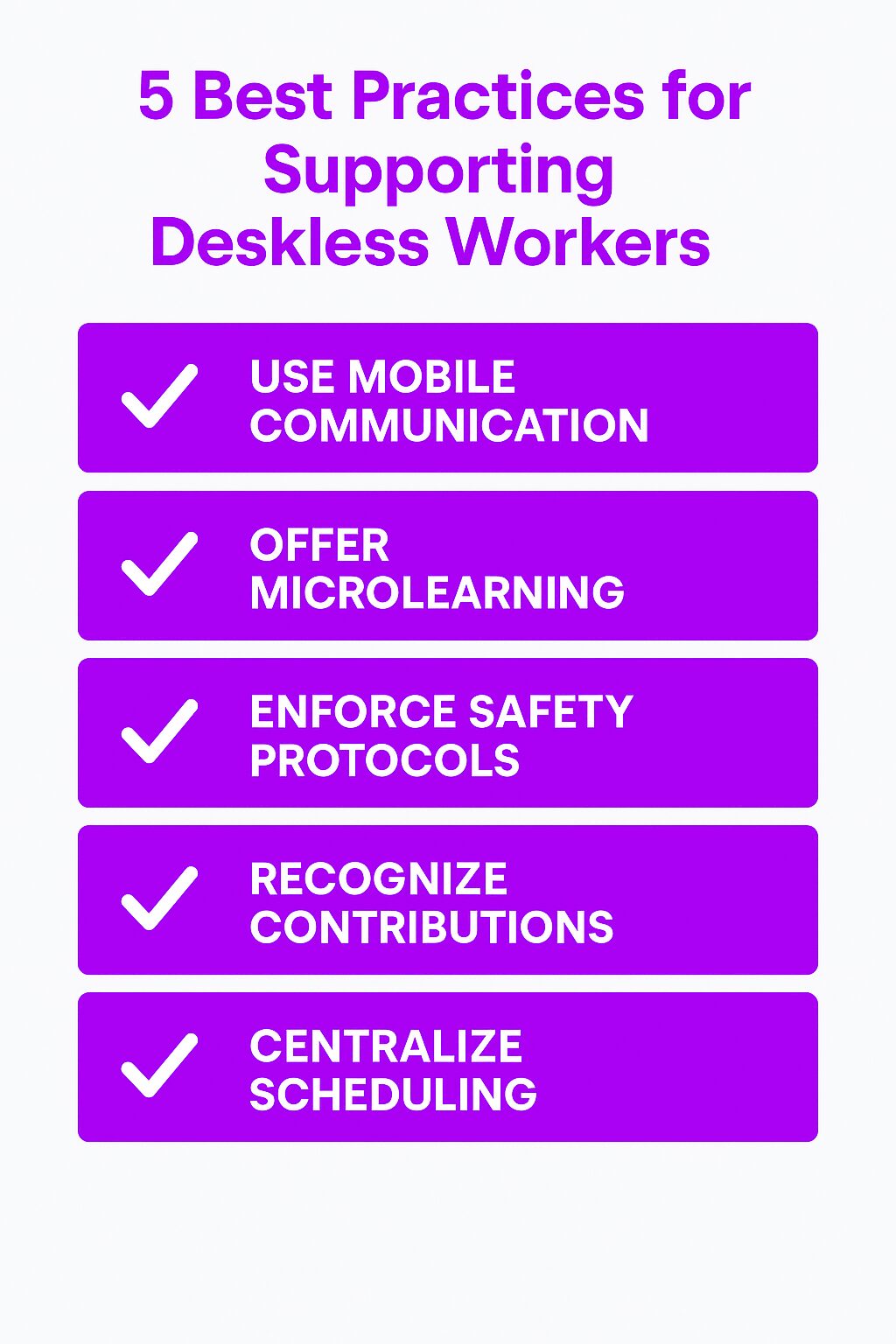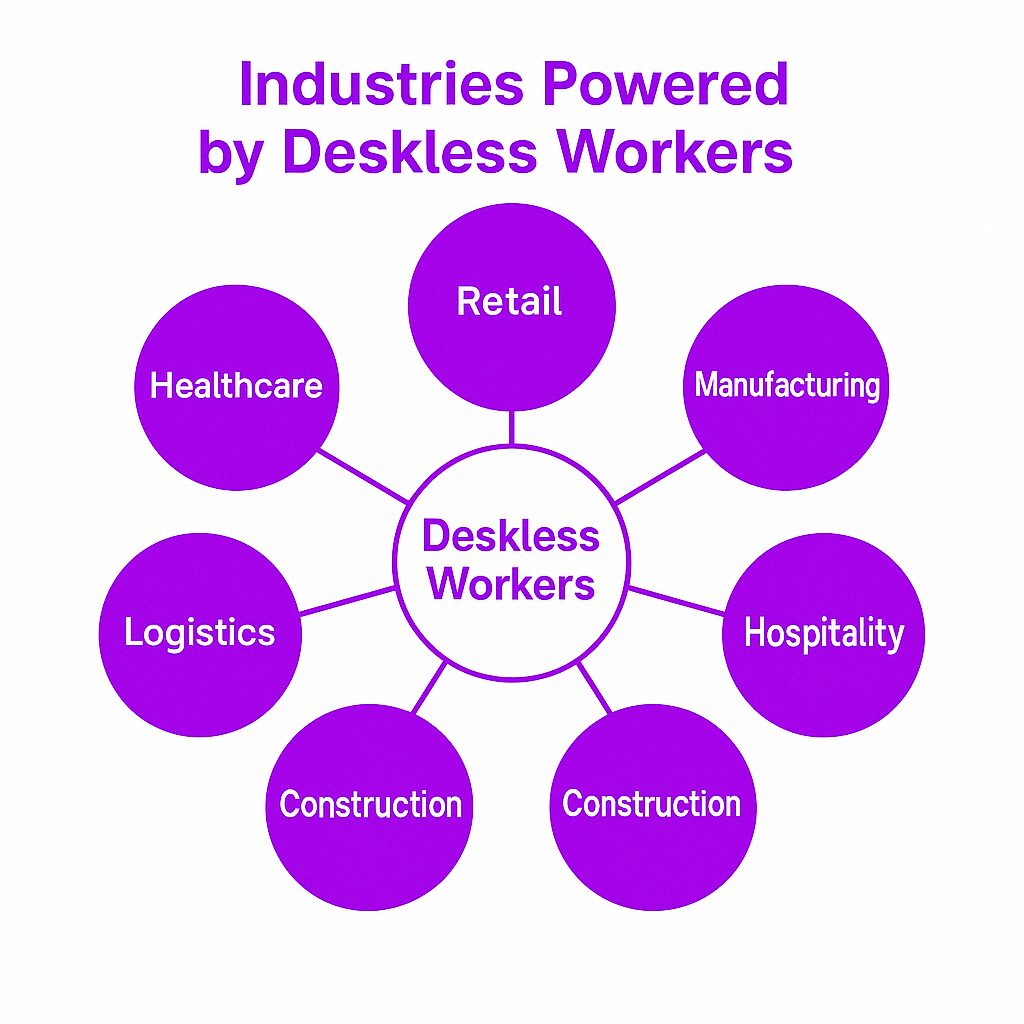What Is a Deskless Worker?
A deskless worker is an employee whose job does not require them to sit at a fixed workstation. Unlike office-based employees who rely on computers and desks, deskless workers perform tasks that involve mobility, physical labor, or customer interaction. They work across industries such as healthcare, retail, manufacturing, hospitality, construction workers, and logistics.
Deskless workers make up a significant portion of the global workforce, yet many companies fail to provide them with the same level of digital tools, training, and engagement opportunities as traditional office workers. Organizations that invest in their deskless workforce can improve productivity, retention, and job satisfaction.
How Deskless Work Operates
Deskless workers perform their duties on the move, often using handheld devices, specialized equipment, or manual tools. They rely on efficient scheduling, clear communication, and accessible training to stay informed and perform their roles effectively. Unlike desk-bound employees, the deskless workforce faces unique challenges that require specialized solutions to ensure productivity and engagement. They may not have access to traditional corporate systems like email or intranets, making it essential for companies to adopt mobile-friendly solutions to keep them connected.
Many deskless roles involve shift work, on-site duties, or field-based operations, meaning these workers depend on streamlined workflows, real-time coordination, and hands-on training. Providing the right resources and technology enhances their ability to work efficiently and safely.
Key Components of Deskless Work
1. Job Execution
Deskless workers perform essential tasks that contribute to a company’s core operations. This includes:
-
Delivering goods or services
-
Operating machinery
-
Providing direct customer service
-
Conducting repairs and maintenance
2. Communication and Coordination
Since deskless workers are often mobile, real-time communication is crucial. Effective communication strategies are essential for both deskless and frontline workers to ensure they remain informed and coordinated. Companies use mobile apps, text alerts, and digital scheduling tools to keep employees informed.
3. Training and Skill Development
Many deskless roles require ongoing training, but traditional methods may not be practical. Companies use mobile learning platforms, microlearning modules, and video tutorials to ensure workers receive proper training. Enhancing the employee experience through effective training programs can lead to higher productivity and job satisfaction among deskless workers.
4. Workplace Safety
Deskless workers are more likely to work in physically demanding or hazardous environments. Ensuring the safety of the frontline workforce is critical, as these workers often face higher risks in their daily tasks. Proper safety training, protective equipment, and compliance with regulations are essential.
5. Technology Integration
Companies use digital tools such as handheld scanners, mobile workforce management apps, and IoT-connected devices to streamline operations and improve efficiency.
Why Deskless Workers Matter
Deskless workers are the backbone of many industries. They are responsible for producing goods, delivering services, and ensuring operations run smoothly. You can find deskless workers in a variety of industries, including healthcare, transportation, and construction, where they perform essential roles. Businesses that recognize their importance invest in better tools, training, and policies to support them.
Impact on Business Success
-
Customer Experience: Retail workers and service staff directly influence customer satisfaction.
-
Operational Efficiency: Manufacturing and logistics workers ensure smooth production and distribution.
-
Public Health & Safety: Healthcare and emergency responders provide essential care and crisis management.
-
Revenue Growth:Engaged and well-supported deskless workers contribute to increased productivity and profitability. Fostering employee engagement among deskless workers is crucial for maintaining high levels of productivity and satisfaction.
Benefits of Deskless Work
1. Increased Flexibility
Deskless workers often have varied schedules, allowing them to work in shifts or remotely. This flexibility benefits both employees and employers by ensuring continuous operations. This flexibility is particularly beneficial for frontline employees who need to adapt to varying schedules and work environments.
2. Higher Productivity
Since their roles involve hands-on work, deskless employees can complete tasks faster without the distractions of a traditional office environment. By improving technology and communication, companies can help deskless workers feel more engaged and productive.
3. Stronger Customer Relationships
Frontline workers, such as sales associates and service personnel, directly interact with customers, helping build relationships and trust.
4. Lower Overhead Costs
Employers save on office space, utilities, and equipment by having a workforce that does not require traditional office setups.
Challenges of Deskless Work
1. Communication Barriers
Without access to corporate emails or internal messaging systems, deskless workers may struggle to stay informed about company updates and policies.
2. Training Limitations
Traditional training programs may not fit the schedules or work environments of deskless employees, making skill development challenging.
3. Workplace Safety Risks
Since many deskless jobs involve physical labor, employees face a higher risk of injury. Employers must implement rigorous safety protocols and training.
4. Job Insecurity
Many deskless roles, such as gig work or seasonal positions, do not offer long-term stability or career growth opportunities. Improving technology and communication can enhance employee retention by making deskless workers feel more valued and supported.
Best Practices for Managing Deskless Workers
1. Improve Communication Channels
-
Use mobile apps or text messaging to relay important updates.
-
Provide a centralized platform for schedules, announcements, and training.
2. Offer Digital Training
-
Implement microlearning courses that workers can complete on their phones.
-
Use video tutorials and interactive simulations for skill development.
3. Enhance Workplace Safety
-
Conduct regular safety training sessions.
-
Provide protective gear and enforce safety regulations.
Recognize and Reward Employee Engagement
-
Acknowledge high-performing workers through bonuses or incentives. Recognizing achievements and providing incentives can empower deskless employees, leading to higher job satisfaction and retention.
-
Create employee recognition programs to boost morale and engagement.
Related Concepts
Frontline Workers and Deskless Employees
Deskless workers who interact directly with customers, such as retail associates, healthcare providers, and hospitality staff. The role of a frontline worker can vary greatly, often requiring adaptability and direct interaction with customers or clients.
2. Remote Work vs. Deskless Work
Remote workers use digital tools to work from any location, while deskless workers perform hands-on tasks that do not require a desk. Unlike remote workers, deskless workers do not operate from a traditional office setting, which presents unique challenges and opportunities.
3. Mobile Workforce Management
The use of technology to coordinate, monitor, and optimize deskless employee performance.
Real-World Examples of Deskless Work
1. Healthcare Industry
Nurses, doctors, and home health aides rely on mobile technology to track patient data and coordinate care.
2. Retail & E-commerce
Store associates use point-of-sale systems and inventory apps to improve customer service and manage stock.
3. Construction & Manufacturing
Workers use wearable technology and mobile management software to enhance safety and efficiency on job sites.
Final Thoughts
Deskless workers are a critical part of the workforce, yet they often face challenges that office employees do not. Companies that prioritize their needs—through better communication, training, and workplace safety—see improvements in productivity, job satisfaction, and customer service. Investing in deskless workers not only benefits employees but also drives overall business success.







